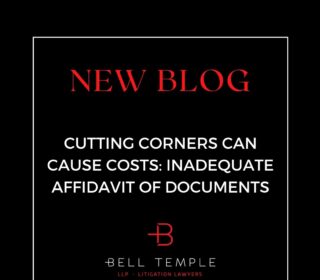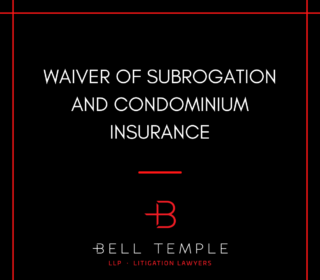With the end of COVID restrictions, the market size of the Gym, Health & Fitness Clubs industry in Canada is expected to increase 7.24% from 2023-2027, which means, more Ontarians getting gym memberships.[1] Every gym membership comes with a membership agreement, which is a contract between the member and the gym owner or operator. That same membership agreement likely came with a liability waiver. Even if no waiver exists, gym goers may still have a difficult task to prove negligence against a gym.
Liability Waiver
Liability waivers in membership agreements typically waive any right to hold the gym or its employees legally responsible if the member becomes injured at the gym. An example of a gym’s liability-waiver clause can be found in the 2019 Ontario Superior Court decision of Hosseinkhani v. QK Fitness Inc[2]. In Hosseinkhani, the plaintiff was injured when she tripped and fell on a dumbbell during a gym class at the defendant’s gym. In Hosseinkhani, Clause 3.3 of the “Membership Agreement — Terms and Conditions” was entitled “Exclusion of Liability”. It was on the reverse side of the Agreement, and indicated:
The Member/Buyer releases the Club, its related companies, their respective directors, officers, employees and agents of and from any claim whatsoever hereafter arising by reason of the Member/Buyer suffering disease, deterioration of health, illness, or aggravation of condition or of ill health as a result of participation in the programmes, acceptance of advice or use of the facilities provided by the Club or any claim for personal injury sustained by the Member/Buyer in, on or about the facilities of the Club and its related companies, including and without limitation any claims for personal injuries resulting from and/or arising out of the negligence of the Club, its related companies, their respective directors, officers, employees and agents or any claim for personal injury resulting from the negligence or advice of any other person using the facilities of the Club and acknowledges that he/she is using the said facilities at his/her own risk.
So, what happens if you get injured at the gym? Is the liability clause enforceable?
Like most things in law, the answer is “it depends”. Section 3(3) of the Occupier’s Liability Act (“OLA”) specifically authorizes an occupier to “restrict, modify or exclude” the general duty of care. Based on two Ontario Court of Appeal decisions, Schnarr v. Blue Mountain Resorts Limited[3], & Best v. Deal[4], the effectiveness of these waivers depends on two issues: 1) whether the language is broad and clear enough to cover the injury claimed by the plaintiff; and 2) whether the occupier sufficiently brought the waiver provision to the plaintiff’s attention before he or she signed.
On the first issue, the court in Jensen v. Fit City Health Centre Inc. maintained that it is “well established” that a general release will not apply to injuries caused by negligence (i.e., a failure to follow a reasonable standard of care) unless negligence is explicitly covered by the waiver. [5] This was done in both Jensen and Hosseinkhani, but not every gym includes negligence in its liability waiver.
The second issue stems from section 5(3) of the OLA, which requires the occupier to “take reasonable steps to bring such restriction, modification or exclusion to the attention of the person to whom the duty is owed”. Placing the term in small print at the back of a lengthy membership agreement will not work. In some cases, the reasonableness of the steps taken to bring the release to the attention of the person signing the agreement may be apparent from the document itself. For example, in Schnarr, the Court of Appeal noted, at para. 7:
One heading, set out in bold type in a yellow box with a red border, specifically instructed the customer to “PLEASE READ CAREFULLY!” and cautioned Mr. Schnarr that by executing the document, he was giving up certain legal rights.
In Hosseinkhani, the Court found that the exclusion clause in the membership agreement was not enforceable since it did nothing to draw the exclusion of liability “to the attention of the person to whom the duty is owed”. This was since:
- The exclusion clause was on the reverse of the Agreement under the general heading “Membership Agreement — Terms and Conditions”.
- The Terms and Conditions were divided into 7 headings and 26 clauses of tightly printed “fine print”.
- There was nothing to point to the signer attention that clause 3.3 of the agreement was significant (or special attention should be paid to it) or that a waiver was buried among the Agreement’s terms.
- The waiver portion of the document was identical in font and size to the rest of the reverse side of the contract, and the font on the reverse was smaller than the font on the front of the Agreement.
- There was no place on the Agreement for the plaintiff to sign or initial the Exclusion of Liability clause, which would have provided evidence that the defendant had made reasonable efforts to bring the waiver to the attention of the signer. [6]
Negligence against a Gym
If the liability clause is deemed enforceable, a member will not be able to sue the gym for any injuries suffered. Assuming that the liability clause is deemed invalid, gym goers may still have a difficult task to prove negligence against a gym. Cases surrounding the OLA have held that a plaintiff must be able to point to some act, or some failure to act, on part of the occupier which caused the injury complained of, before liability can be established.[7] The duty of care on the occupier does not extend to the removal of every possibility of danger. The OLA does not impose strict liability and the presence of a hazard does not in itself lead inevitably to the conclusion that the occupier has breached its duty to take such reasonable care to see that persons on the premises are reasonably safe while on the premises.[8] The standard of care is not perfection but rather reasonableness. The measure of what is reasonable depends on the facts of each case including foreseeability, the gravity of the possible harm, the burden of the cost of preventive measures, industry practice, custom, and regulatory standards applicable to the circumstances[9]. The onus is on the plaintiff to prove on a balance of probabilities that the defendant was in breach of a positive duty of care.
In concluding that there was no negligence on the gym, the Court in Hosseinkhani relied on the fact that the exercise activities involved were simple and the skills involved were rudimentary. There was no allegation that the round dumbbells were defective or inherently dangerous when properly used. There was no evidence that the round dumbbells represented an unusual hazard or that the defendant had any reason to believe that they were hazardous. There was no evidence that the round dumbbells were not reasonably safe for the purpose for which they were intended. The evidence indicated that they had been used thousands of times without incident. An 8-pound dumbbell was not deemed a complicated exercise machine that may require instruction on proper use and safety. The dumbbells were not being used in an unusual fashion or for a purpose for which they were not intended. The risk that a round dumbbell might roll was considered an obvious risk. The Court found that an occupier has no duty to warn an adult about obvious risks and that the plaintiff had not proven a prima facie case of negligence against the defendant gym.
Takeaways
If you own a gym, it is important you make it clear negligence will be excluded as part of any liability clause in the membership agreement. The exclusion clause should be in bold and legible font and not at the very end of the agreement. The font size should also be larger than the other clauses on the same page or section. Getting a member to sign or initial beside the exclusion clause can help prove the clause was understood and brought to the attention of the member.
If you are a member of
a gym, you want to ascertain you understand the provisions of any exclusion
clause. Some exclusion clauses may not cover the more complex exercise machines
or exercises, which may allow for liability to be placed on a gym if an injury
occurs. It is important that you are aware of the potential hazards and risks
involved in the workout, but also be mindful that there is no duty by a gym to
warn a member of an obvious hazard which the member should reasonably be or is
already aware of.
[1] https://www.statista.com/outlook/dmo/app/health-fitness/canada
[2] Hosseinkhani v. QK Fitness Inc., 2019 ONSC 70 (CanLII) at para. 75, <https://canlii.ca/t/hwt0g>
[3] Schnarr v. Blue Mountain Resorts Limited, 2018 ONCA 313 (CanLII), <https://canlii.ca/t/hr7bp>,
[4] Best v. Port Hope Golf & Country Club, 2008 ONCA 26 (CanLII), <https://canlii.ca/t/1vf75>
[5] Jensen v Fit City Health Centre Inc., 2015 ONSC 6326 (CanLII) at para 32, <https://canlii.ca/t/gncps>
[6] Supra note 2 at para. 75
[7]Hamilton v. Ontario Corporation #2000533 o/a Toronto Community Housing Corporation, 2017 ONSC 5467 (CanLII) para. 31-33, <https://canlii.ca/t/h65mp>
[8] Drummond v. The Cadillac Fairview Corp. Ltd., 2018 ONSC 4509 (CanLII) at para. 28, <https://canlii.ca/t/ht7k4>
[9] Ibid







